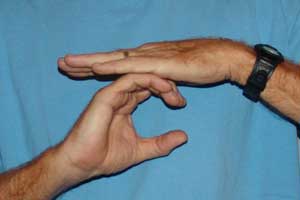

![]()
"Chill out"
Teacher (during a seminar):
I've got a couple of students who can really get wound up in class. To help them regain control without having to use my voice, I use a sign I made up, I took the "Time Out" sign used in sports and modified it. Instead of forming a T with both hands, I turned the vertical part of the T into a C.

All I have to do is turn to the student and show them the "Chill Out" sign. I usually bounce the top hand on the C hand a couple of times. And even though I'm not using my voice, the students are receiving the signal loud and clear.
You gotta love sign language.
![]()
Sign for "May I get a drink?"
(Question asked during seminar)
I was introducing the idea of the use of sign language in the classroom when I asked the group if any of them were already using sign language and, if so, what signs were being used. I got the typical responses: a sign for restroom; signs for I have a question, I have a comment, and I have an answer; and the signs for sit and stand. It was then that a teacher offered that her students used a sign for needing to get a drink.
Being an opinionated kind of a guy, I responded by saying that the sign for getting a drink or using the pencil sharpener are not ones I have my students use. My feeling is students should be able to determine when it is appropriate to get a drink or sharpen a pencil without having to ask for the teacher's permission to do so. And, as is usually the case, there are reasons why I do it this way.
Reason One
If a student is always required to ask permission for these things, he's never going to develop the ability to assess the situation on his own and determine if it's appropriate to do so.
He's just going to raise a hand and ask the teacher. I don't think, I just ask. Sometimes the answer is Yes and sometimes the answer is No. I'm never sure why.
The predictable outcome of this much Teacher Welfare is that students never develop the ability to assess the environment to determine the appropriateness of this type of action. And before you know it, May rolls around and you still have students who do the following:
Student
Approaching the teacher and asking quietly:
May I sharpen my pencil?Teacher
Somewhat alarmed:
While our guest speaker is talking? I don't think so!
Reason Two
If opportunities to get up and move around--either to sharpen a pencil or get a drink--are limited to a small number each day, then the students are going to take advantage of those few times and get as much out of them as they can. Consequently, on the way to getting a drink, the student smacks four kids, pushes a book off a desk, and taunts someone. And that's just on the way to the fountain. On the way back, it'll be more of the same.
However, if there are many opportunities to get out of your seat--always for an appropriate reason and always done with self-control--then the novelty of getting out of your seat wears off and the whole process becomes a normal part of the day. As a result, the nuisance issues go away.
As I've said before, freedom is a student need. And in the classroom, freedom is nothing more than the opportunity to make choices. This is a big deal because, according to the research, it's the choices children make that help to build their character.
Sadly, though, the students who need the most freedom are usually the ones who are allowed the least.
![]()
Sign language crib sheet for substitute teacher
During a discussion of the use of sign language in the classroom, one of the teachers offered a great idea. She thought it might be beneficial to leave some kind of a crib sheet of signs, along with the sub plans, so that any visiting teacher--the term our district used for substitute teachers since they seemed to think "substitute" was demeaning--would be able to decipher the signs being used by the students.
With that thought in mind, I've created a one-page sheet of signs and what they mean. Feel free to download the file and print out a copy.
Download the sign language sheet
